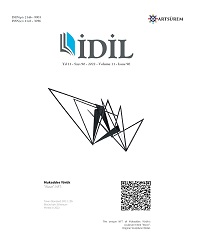CRYPTO ART PERCEPTION OF UNIVERSITY STUDENTS WITHIN THE SCOPE OF NFT-BLOCKCHAIN PLATFORM
CRYPTO ART PERCEPTION OF UNIVERSITY STUDENTS WITHIN THE SCOPE OF NFT-BLOCKCHAIN PLATFORM
Author(s): Ceylan Sebik Gündüz, Gamze Eryılmaz, Yeliz YaziciSubject(s): Business Economy / Management, Visual Arts, ICT Information and Communications Technologies
Published by: Sanat ve Dil Araştırmaları Enstitüsü
Keywords: Crypto Art; Arts Economy; Blockchain; Interdisciplinarity; Digital Arts;
Summary/Abstract: This research is based on university students' perception of NFT (Non-fungible token). It is aimed to examine the perception of crypto art within the scope of the blockchain platform. The population of the research, which was developed with a quantitative research design, was students from all fields studying at Ondokuz Mayıs University, and the sample was determined as 384 randomly selected students from these students. As the data tool of the research, it was obtained from the questionnaires conducted with the students studying in the fields of science, social, health and fine arts in the academic fall semester of 2021-2022 at Ondokuz Mayıs University in Samsun. Data; NFT has been evaluated in two groups according to whether they are aware of crypto art or not. The results of the research show that 55.5% of the students are aware of the concept of NFT, 31.3% of them use the Cryptocurrency system and 5.7% of them use the crypto art NFT. In terms of being aware of NFT crypto art; A statistically significant relationship was found in terms of gender, the unit where he studied, the relationship between himself and his parents with art, his and his mother's closeness with technology, and the type of art he was interested in. When the reliability of the blockchain crypto platforms was evaluated, 35.6% of the students stated that they found this system reliable. As a result, although the level of use of crypto art systems, which is a very new concept, among university students is low, it shows significant changes in the awareness levels of the participants according to the relationship between them and technology. NFTs use smart contracts to verify ownership and terms. However, as it is clearly seen in the research findings, the majority of the students stated that they are undecided about the reliability of blockchain systems. “Does a work of art replace the original?” In the premise, most of the students disagree option was coded. In the context of research findings, most of them are aware of NFT and they see themselves as potential NFT producers. The impact of digitalization and rapid spread, especially on the young generation, is undeniable. When we look at the situation in the context of art economy, it can be said that the perspective towards the acceptance of art as an economic tool suitable for the arguments of the digital world, as in many disciplines, will change relatively.
Journal: İdil Sanat ve Dil Dergisi
- Issue Year: 11/2022
- Issue No: 90
- Page Range: 261-273
- Page Count: 13
- Language: English

